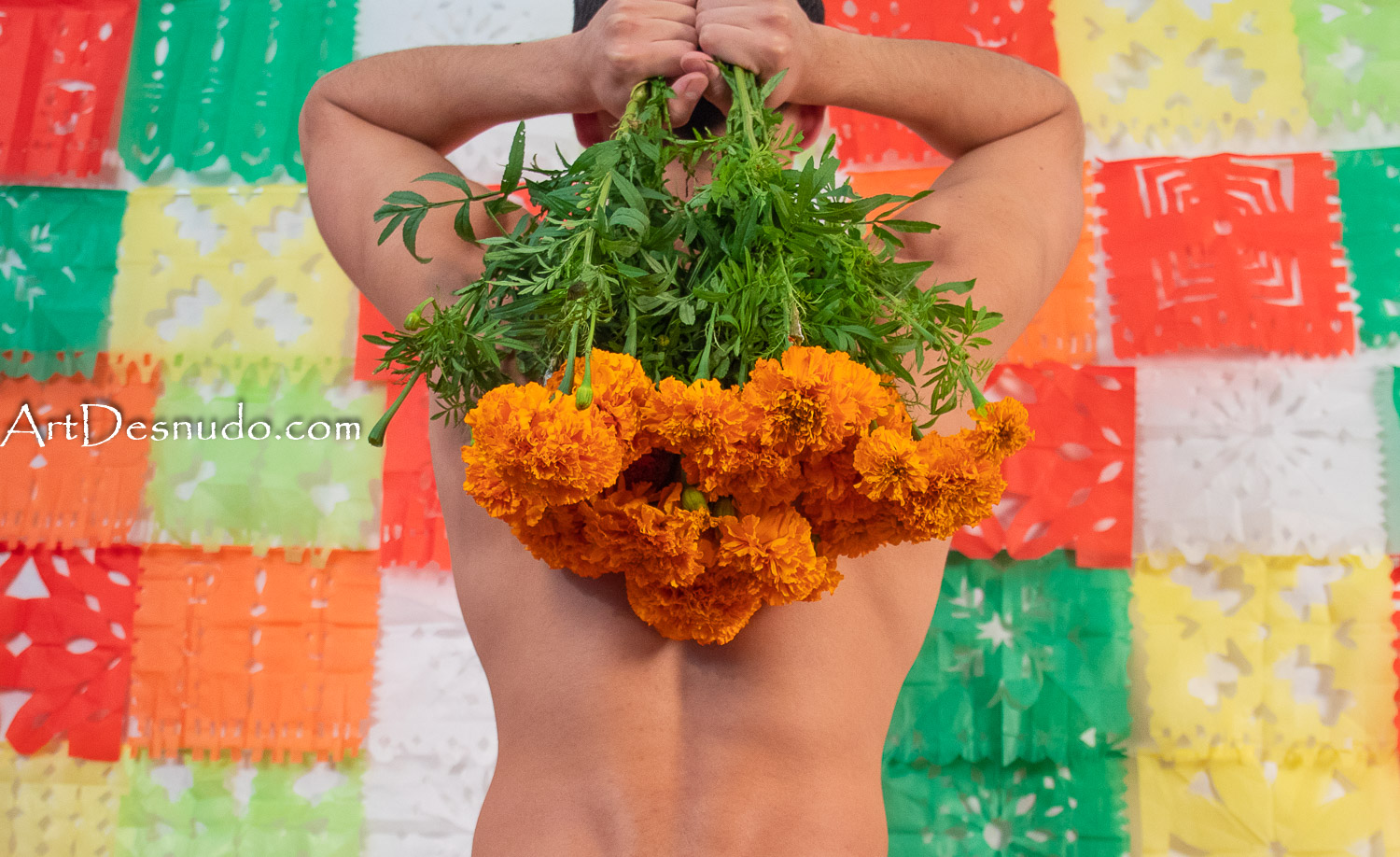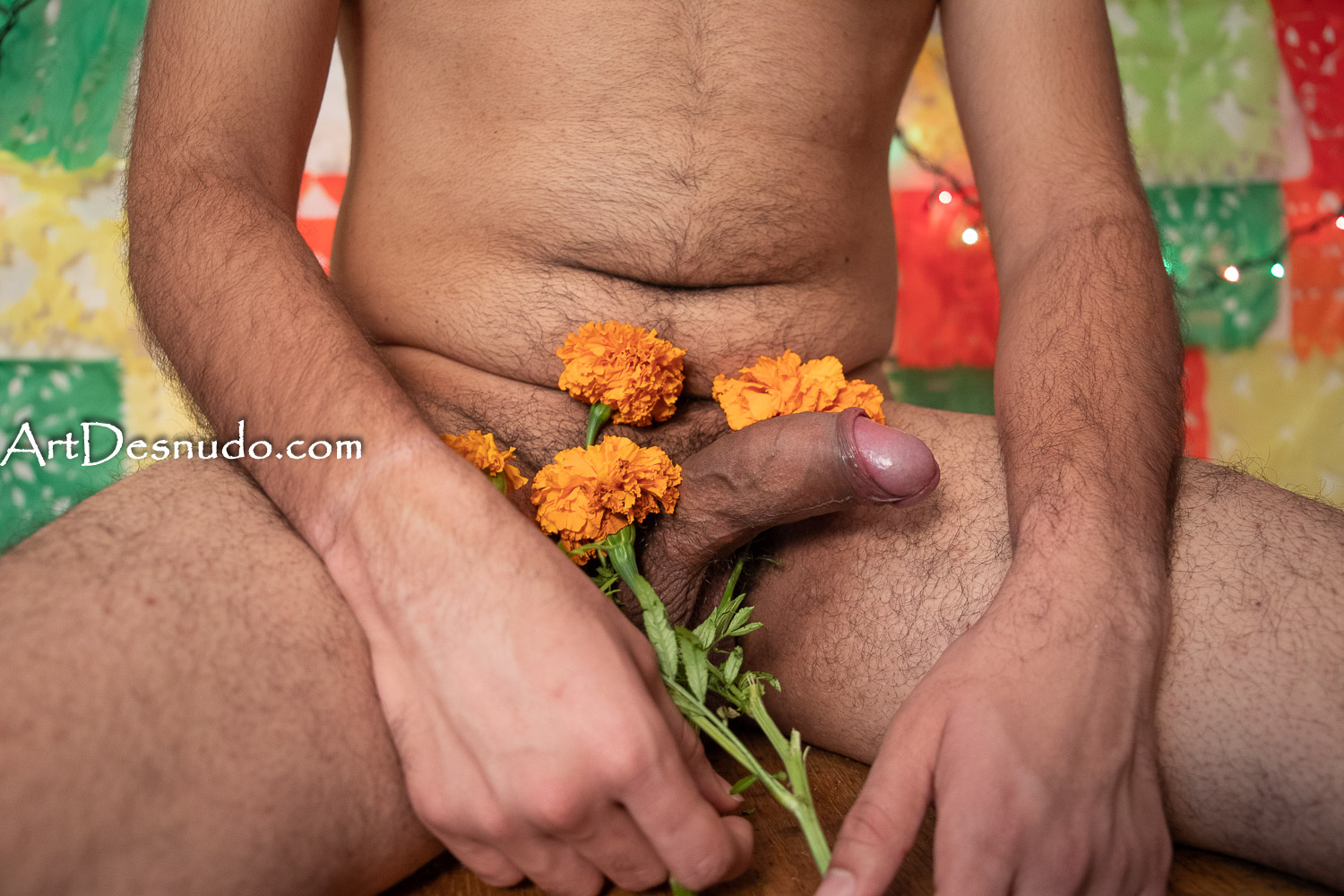Wednesday, November 6, 2019. New York City – I had a nude photo shoot with model “Poncho” and model “Johnson” to celebrate Day of the Dead (if you are offended by the beautiful naked human body, then get out of my website and go to a planet where you will never see a naked human being…).
In 2008, this Mexican tradition was inscribed in the Representative List of the Intangible Cultural Heritage of Humanity by UNESCO.

Women and men in New York City (Brooklyn, Bronx, Queens, Staten Island and Manhattan), if you would like to create nude art with your nude body, fill out the contact form to send me a message. You get FREE pictures. Click here for info about FREE pictures and click here for info about a private nude photo shoot. You do not need experience!
We can also create a nude art video. Click here for information about videos.


Cempoalxóchitl flower
Cempoalxóchitl flower (Mexican marigold or Aztec marigold) is native to Mexico. It smells so good.
In Mexico Cempoalxóchitl flowers are used in the festivities of the Day of the Dead, to decorate altars and tombs. Mexicans call them Cempoalxóchitl or “flower of the dead”. Since antiquity, it is also used for food and medicinal purposes by indigenous people.
Pan de muerto
Pan de muerto (Spanish for “bread of the dead”). It is a type of sweet bread traditionally baked in Mexico for the celebration Día de Muertos. Mexicans in the United States of America also bake this pan de muerto for Day of the Dead.
Papel picado
Papel picado is a Mexican folk art. Papel picado (“perforated paper,” “cutted paper,” “pecked paper”) is a decorative craft made by cutting elaborate designs into sheets of tissue paper. Papel picados are commonly displayed for both secular and religious occasions, such as Easter, Christmas, the Day of the Dead, weddings, quinceañeras, baptisms, and christenings. Papel picados are often hung throughout the streets during holidays.

“The Day of the Dead (Spanish: Día de Muertos) is a Mexican holiday celebrated throughout Mexico, in particular the Central and South regions, and by people of Mexican heritage elsewhere. The multi-day holiday involves family and friends gathering to pray for and remember friends and family members who have died, and helping support their spiritual journey. In Mexican culture, death is viewed as a natural part of the human cycle. Mexicans view it not as a day of sadness but as a day of celebration because their loved ones awake and celebrate with them. In 2008, the tradition was inscribed in the Representative List of the Intangible Cultural Heritage of Humanity by UNESCO.
The holiday is sometimes called Día de los Muertos in Anglophone countries, a back-translation of its original name, Día de Muertos. It is particularly celebrated in Mexico where the day is a public holiday. Prior to Spanish colonization in the 16th century, the celebration took place at the beginning of summer. Gradually, it was associated with October 31, November 1, and November 2 to coincide with the Western Christian triduum of Allhallowtide: All Saints’ Eve, All Saints’ Day, and All Souls’ Day. Traditions connected with the holiday include building private altars called ofrendas, honoring the deceased using calaveras, aztec marigolds, and the favorite foods and beverages of the departed, and visiting graves with these as gifts. Visitors also leave possessions of the deceased at the graves.
Scholars trace the origins of the modern Mexican holiday to indigenous observances dating back hundreds of years and to an Aztec festival dedicated to the goddess Mictecacihuatl. It has become a national symbol and as such is taught (for educational purposes) in the nation’s schools. Many families celebrate a traditional “All Saints’ Day” associated with the Catholic Church.
Originally, the Day of the Dead as such was not celebrated in northern Mexico, where it was unknown until the 20th century because its indigenous people had different traditions. The people and the church rejected it as a day related to syncretizing pagan elements with Catholic Christianity. They held the traditional ‘All Saints’ Day’ in the same way as other Christians in the world. There was limited Mesoamerican influence in this region, and relatively few indigenous inhabitants from the regions of Southern Mexico, where the holiday was celebrated. In the early 21st century in northern Mexico, Día de Muertos is observed because the Mexican government made it a national holiday based on educational policies from the 1960s; it has introduced this holiday as a unifying national tradition based on indigenous traditions.”_Wikipedia.org

Support art. Click here to become my Patreon and GET REWARDS. Share this post on social networks, follow me on Instagram, “LIKE” my Facebook page, follow me on Twitter, follow me on Flickr, subscribe to my Youtube channel and be my friend on ModelMayhem. You can contact me directly by filling out this form.
Comparte este artículo en las redes sociales, sigueme en Instagram, dale “ME GUSTA” a mi página en Facebook, sigueme en Twitter, sigueme en Flickr, suscribete a mi canal de Youtube y se mi amigo o amiga en ModelMayhem. Puedes ponerte en contacto conmigo directamente llenando esta forma.
